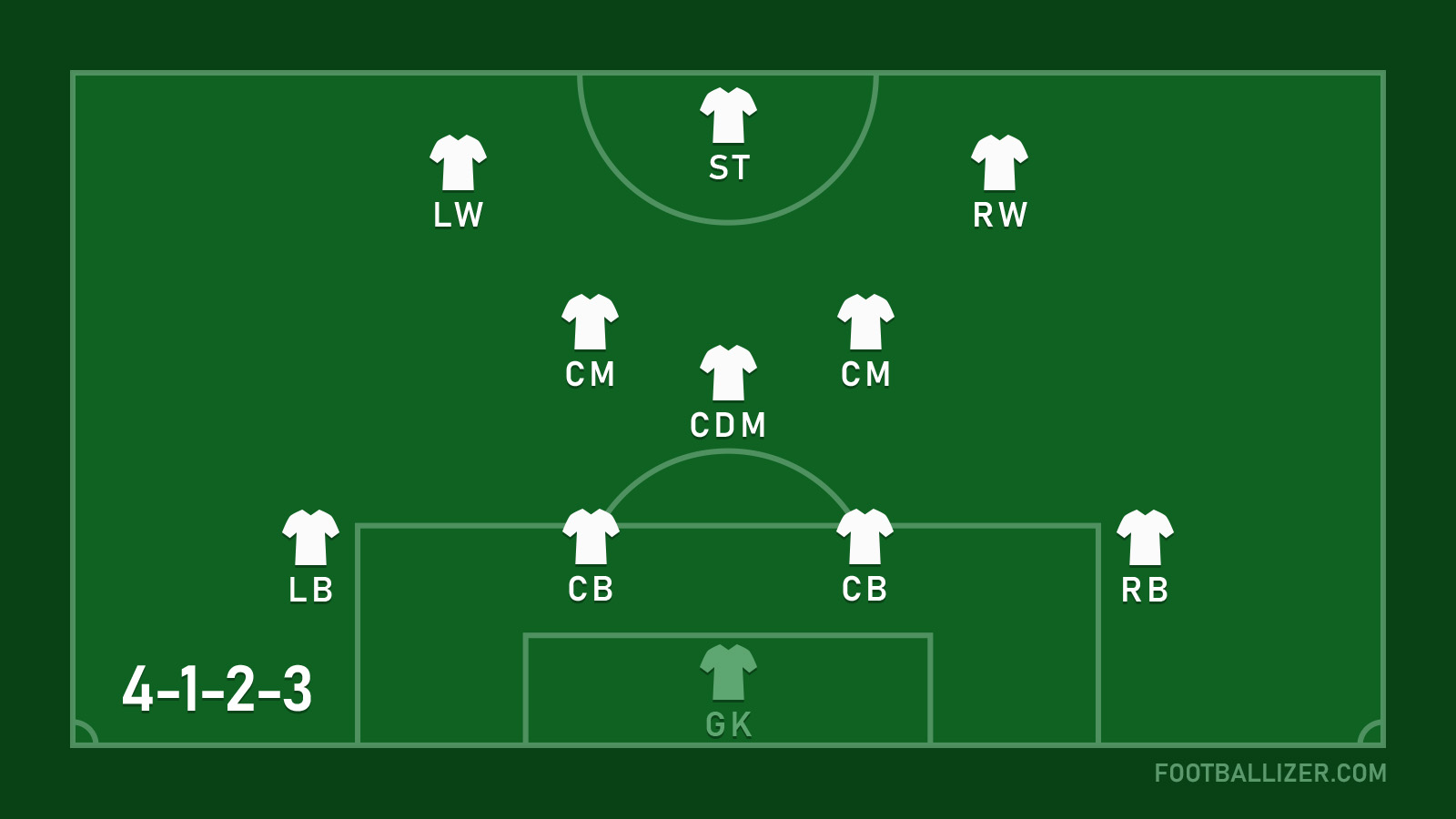4-1-2-3 Formation

The 4-1-2-3 formation, known for its dynamic and offensive style, is a tactical system that blends defensive stability with a powerful attacking force. This formation is highly regarded for its ability to dominate the midfield while providing numerous offensive alternatives. The 4-1-2-3 system, which consists of four defenders, one defensive midfielder, two central midfielders, and a front three made up of two wingers and a central striker, provides a balanced and formidable presence on the field. Here's a detailed breakdown of each position:
Defenders: The defensive unit consists of two central defenders and two fullbacks. The centre defenders serve as the backbone, demonstrating defensive strength, aerial ability, and the ability to start plays from the back. Meanwhile, fullbacks are instrumental in providing width in attack, making overlapping runs, and delivering precise crosses into the penalty area.
Defensive Midfielder - Positioned just in front of the defense, the lone defensive midfielder serves as a shield, disrupting opposition plays and distributing the ball efficiently. This player is crucial in breaking up attacks, intercepting passes, and initiating the team's build-up play from a deeper position.
The two central midfielders have a dual role, balancing defensive responsibilities with an emphasis on ball distribution and creative play. They must excel in both tackling and passing, serving as the link between the defensive and offensive groups. These players frequently contribute to the team's possession game and assist the front three.
Wingers - The two wingers, who are positioned on each side of the central striker, play an important role in stretching the opposition's defence, creating scoring opportunities, and delivering accurate crosses into the box. Wingers are recognised for their speed, dribbling ability, and flare, which offer an unpredictable element to the team's offensive play.
Striker - The central striker leads the offensive line, with the purpose of converting chances into goals. This player should have clinical finishing talents, the ability to hold up play, and the ability to link up with the wingers and central midfielders. Movement and positioning of the striker are critical for breaking down opposition defences.
The 4-1-2-3 formation provides teams with a diverse framework from which to adjust their playing style based on the squad's abilities and the specific needs of a contest. This formation provides a solid structure for teams seeking a balanced blend of defensive resilience and offensive prowess, whether focusing on dominating possession or launching rapid counter-attacks.
Advantages
Defensive Stability
A single defensive midfielder adds an extra layer of protection to the backline. This player serves as a defensive barrier, disrupting opposing attacks and offering additional defensive protection.
Midfield Control
With three centre midfielders, the formation provides stronger midfield control. The central midfield trio can control possession, affect the tempo of the game, and win midfield fights.
Build-up Play
The formation's structure allows for a fluid build-up play from the defence via the lone defensive midfielder. This player frequently receives the ball between the center-backs and initiates assaults from a deeper position.
Versatile Attack
The front three, consisting of two wingers and a central striker, creates a dynamic and versatile attacking force. The wingers provide width, stretching the opposition defense, while the central striker acts as a focal point for goal-scoring opportunities.
Pressing and Transition
The formation facilitates effective pressing, especially in the midfield and attacking areas. The central striker and wingers can lead the press, while the lone defensive midfielder provides cover in transition moments.
Disadvantages
Vulnerability to Counter-Attacks
The lone defensive midfielder may leave gaps behind when pressing high or during turnovers, making the team susceptible to counter-attacks. If the opposition quickly transitions from defense to offense, it can exploit the space left in front of the defensive line.
High Defensive Line Danger
Teams that use a high defensive line to compact the playing area may be vulnerable to through balls or long passes, particularly if the defensive midfielder is caught off guard. Fast opponents can take advantage of the space behind the defensive line.
Defensive Midfielder Under Pressure
The lone defensive midfielder is in charge of the entire defence. If this player is overpowered or dominated by the opposing midfield, it can lead to defensive weaknesses and difficulty regaining control.
Winger Defensive Responsibilities
Wingers in this formation are often expected to contribute defensively by tracking back and helping the fullbacks. This defensive responsibility can be demanding, especially for wingers who are primarily known for their attacking prowess.
Rigidity in Style
While the formation is versatile, teams that heavily rely on the 4-1-2-3 structure may become predictable. Opponents who effectively counter the wide play or neutralize the lone defensive midfielder can limit the team's effectiveness.
How to Counter 4-2-3-1 Formation?
Overload the Midfield: Add an extra midfielder to disrupt the formation's central control, limiting the influence of the lone defensive midfielder.
Press High and Disrupt Build-up: Apply high-pressure tactics to force turnovers during the 4-1-2-3 formation's build-up, creating opportunities for counter-attacks.
Exploit the Wide Spaces: Target wide areas, taking advantage of fullbacks caught upfield. This can lead to effective counter-attacks.
Defensive Compactness: Maintain compact defensive lines to limit space, forcing the 4-1-2-3 formation to play in wider areas and reducing its threat.
Man-Marking Key Players: Assign players to man-mark key individuals, disrupting their influence and creating numerical advantages.
Counter with Pace: Use fast players to exploit spaces left by the high defensive line, creating quick transitions and offensive opportunities.
Target the Defensive Midfielder: Apply pressure on the lone defensive midfielder to limit their influence and disrupt the formation's build-up.
Switch Play Quickly Circulate the ball swiftly and switch play to stretch the formation horizontally, creating openings in the defensive lines.
Set Pieces and Aerial Duels: Exploit set-pieces and aerial duels, especially if the defensive unit is vulnerable in these situations.
Control Possession: Control possession to frustrate the 4-1-2-3 formation, disrupting their rhythm and limiting their attacking opportunities.
Suggested Counter Formations
- 4-3-3
- 4-2-2-2
- 4-2-3-1
- 4-5-1
- 3-5-2
- 5-3-2